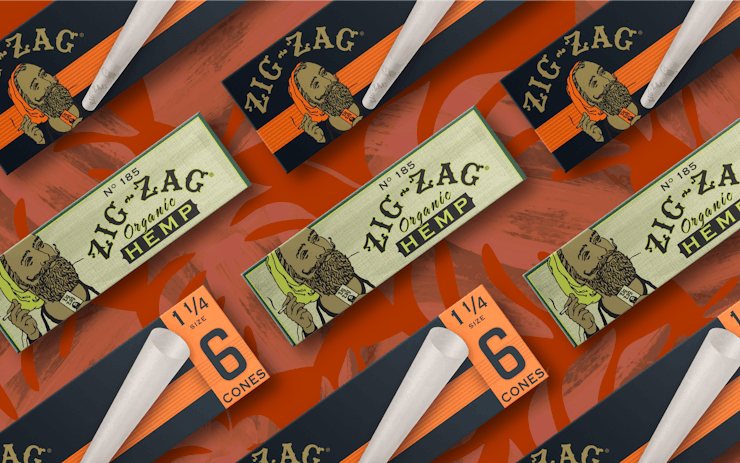There’s nothing like a joint. While there are many perfectly acceptable ways to consume cannabis, a joint is an art. They’re easier to roll than you think, but that extra bit of effort makes it that much more satisfying to smoke.
It all starts with your favorite strain and the perfect rolling paper—and while you probably have the cannabis covered, picking out a paper from all the options on the market can seem overwhelming. Once you know the basics, though, you’ll be discovering your joint-rolling talent in no time.
Choose your fiber
Wood pulp
Traditional wood-pulp papers are a classic for a reason: They’re the easiest to roll and are incredibly sturdy. While they’re the fastest, simplest way for a beginner to get a joint together, they burn fast and hot, though, so you can end up with a joint that smokes too quickly or unevenly.
Hemp
There’s something nice about rolling a hemp joint—you’re just adding more cannabis on top of the cannabis. Hemp papers are thin, sturdy, and easier to roll than other plant fibers, and the mild flavor won’t disrupt the natural taste of your cannabis. They are a little trickier to work with than wood pulp, but they’re a great place to start branching out. Hemp is an ultra-sustainable crop, so it’s a great choice for the environment, too.
For a sustainable option, Zig-Zag’s hemp rolling papers are made with fibers from organic farms.
Rice
Rice papers are tricky, but incredibly rewarding, because of their ultra-thin profile. They can be a little slippery, but they burn slow—and look really cool.
Flax
Flax paper is the best of all worlds: thin like rice, but easy to roll like wood pulp or hemp. Because of their low profile, flax joints have less combustion, so you’re tasting less smoke and more of the good stuff.
Fiber blends
Each rolling paper material has its benefits and drawbacks, so sometimes the best choice is a blend. Zig-Zag usually blends wood pulp with other natural plant fibers for an easy roll and a slow, even burn. Their famous white papers and classic orange packs are made from natural flax fibers.
To bleach or not to bleach?

While there’s a lot of chatter in stoner circles about whether unbleached papers are safer, there’s really one main difference between the two: color.
While some have mistakenly claimed that “unbleached” means that white papers are made with household bleach or something like it, this is not the case. Zig-Zag white papers use an oxygenation process that leaves no residue of any kind on the paper. There is no “bleach” or chlorine used in the whitening process. “Unbleached” simply means the papers skip this step which means the paper has that natural hue of the fibers versus a classic white look.
If you love the tried-and-true white and orange packs, you can smoke them with confidence. But for customers that prefer unbleached, Zig-Zag has you covered. Their standard 1.25-inch papers are available unbleached, but just as easy to roll and satisfying to smoke. If you prefer to roll bigger, the ultra-thin King Slim unbleached papers have you covered. Even the packaging is unbleached and decorated with vegetable inks.
Zig-Zag’s full line of organic hemp papers are all unbleached, just as nature intended.
The glue that holds it all together

You need your joint to stick together, but built-in adhesives on rolling papers can hide a lot of chemicals. If a rolling paper doesn’t have its glue ingredients listed, it’s best to stay away.
Zig-Zag uses 100% gum arabic adhesive, which is a kind of tree sap. It’s the same stuff used on postage stamps, and provides an all-natural, secure hold.
There are other all-natural options—some rollers use glue made from sugar. Gum arabic is the clear choice for both safety and dependability.
What to know about novelty papers
Rolling joints is fun, and mixing it up with the occasional flavored or colorful paper seems harmless. But take a second look before you wrap your Grape Ape in some grape flavor. Recent research showed that flavored blunt wraps were much higher in pesticides, lead, and other contaminants than other rolling papers. Cellulose paper, which is clear to show off the herb inside, had the highest levels of contaminants.
It’s best to go with a trusted brand if you want to add a little whimsy to your joints. Or better yet, try some advanced-level joint rolling, like an L-joint or tulip. Some extra-creative rollers have even made scorpions.
If you want to see your weed while you’re smoking it, try an ultra-thin paper, like Zig-Zag’s translucent ultra-thin papers, instead.
Added convenience

No time or energy to roll a joint today? Sick of inhaling shake? Cones, like Zig-Zag’s standard, unbleached, and king-sized cones, are a really easy option—you just stuff and twist for a thick, secure joint. If you just want to make joint-rolling a little easier, those little cigarette-rolling devices work just as well for cannabis, too.
Ready to start rolling? There’s no greater authority on rolling papers than Zig-Zag. The iconic company has been a staple of hand-rolled cigarettes and joints. Zig-Zag is so deeply ingrained in cannabis culture that Dr. Dre featured them on the album cover for The Chronic. If your great-grandpa smoked, chances are he used Zig-Zags. Zig-Zag’s bundles are there to get you started, complete with rolling trays with the iconic design.






